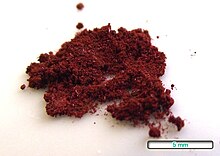Acriflavine
Acriflavine was developed in 1912 by Paul Ehrlich, a German medical researcher, and was used during the First World War against sleeping sickness and as a topical antiseptic.
[2] Acriflavine is used in biochemistry for fluorescently labeling high molecular weight RNA.
[3] Acriflavine might be effective in fighting common cold virus, and also aid the fight against increasingly antibiotic resistant bacteria [4][5][6] because it can cure (remove) plasmids containing antimicrobial resistance genes from Gram positive bacteria.
[7] Since 2014, acriflavine has been undergoing testing as an antimalarial drug to treat parasites with resistance to quinine and modern anti-parasitic medicines.
The use, storage and preparation of the chemical is subject to strict state and territory laws.

